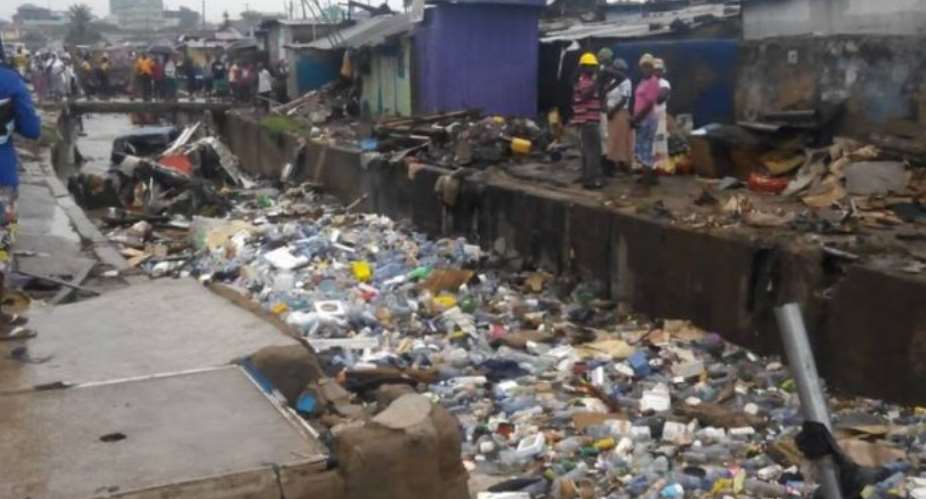Dirt everywhere concerns people everywhere.
The gold of yesterday, a brass for today.
Stained clothes are for Wash. But who cares for the garbage?
Lamps for light, rubbish for a carpet.
Refuse, not flowers, a decoration on the street.
Till we accept we can change,
Nature will have no other alternative than to take an action.
Sanitation has become a challenge in our part of the world. Over the years, effort has been made by different government administrations to usher the country into a proper phase of sanitation.
In April 2017, President Nana Addo Dankwa Akufo-Addo pledged to make Accra the neatest and best city in Africa. By the end of his first term in office, if I may quote verbatim, “The commitment we are making and which I want you all to make with me is that by the time we end our four-year term, Accra is going to be the cleanest city in Africa,” he stated.
Merriam webster defined sanitation as the promotion of hygiene and prevention of disease by maintenance of sanitary conditions such as proper disposal of waste and desilting of sewage.
According to W.H.O Sanitation generally refers to the provision of facilities and services for the safe disposal of human urine and faeces.
The world health organization report in 2017 state that 2.0 billion people still do not have basic sanitation facilities such as toilets or latrines.
And about 673 million still defecate in the open, for example in street gutters, behind bushes or into open bodies of water.
A key challenge facing many countries in the developing world undergoing rapid urbanization is the issue of sanitation and waste management.
Poor sanitation and high-risk hygiene behaviors confine the poor in a vicious cycle of poor health, environmental degradation, malnutrition, reduced productivity and loss of incomes. For women and adolescent girls, the lack of privacy and dignity has deleterious impacts on health and safety, self-esteem, education and well-being.
Ghana, for the past years have gone through rapid urbanization The level of urbanization rose from 7.8% in 1921 to about 23% in 1960, then to 32% in 1984. It reached about 44% in 2000 (GSS 2005), and was estimated by UNFPA to be 51% in 2009 (UNFPA 2009).
According to AMA (2006) sanitation in Accra can best be described as unsatisfactory, and is characterized by choked drains, indiscriminate waste disposal and overflowing central waste containers, especially in poor neighborhoods of the city. And the city still face the problem till now. This situation is attributable to a number of factors, including poor conceptualization of sanitation; lack of adequate sanitary facilities; ignorance and irresponsibility of individuals, households and communities; lack of community action; and the rapid springing up of unauthorized temporary structures. Other factors include an increasing number of squatters; indiscriminate street hawking; lack of regular budgetary allocation for sanitation; and the virtual absence of fee‐based service provision in low‐income areas (AMA 2006). As a result of these challenges, most of the waste generated in Accra is uncollected and ends up in the gutters, water bodies and other open spaces. It is is believe that Accra generates over 1800-2000 tons of waste per day. On average, 1600 tons of the waste generated in the city is collected daily leaving other tons of waste uncollected.
The effects of poor urban sanitary conditions and waste management on the well‐being of city residents are often expressed in health and environmental terms.
social consequence of poor sanitation and waste management is its effects on children. According to Bartlett (1999), poor living environments have particularly far‐reaching consequences for children and adolescents as they are more vulnerable than adults to a range of environmental concerns and more likely to be affected in ways that have longer‐term repercussions.
The poor state of sanitation and the physical living environment have implications for community characterization and stigmatization by “others.
This reminds me of the June 3 incidents:
Memories of tears when the strange fire and rains became companions they both fought with us for our space but brave was the fire that day on the greasily flood. The affected people scars obviously tell the account in full. We close their pathways and they enter our homes. They innocently conducted a mass burial service passing by.
But unintentionally were nature's action.
The president, political, the opinion leaders and the chiefs should remember the bleeding scars and let those scars serve as a reference for better future.





 OSP cleared Cecilia Dapaah of corruption offence not me – Godfred Dame
OSP cleared Cecilia Dapaah of corruption offence not me – Godfred Dame
 Election 2024: EC to commence replacement of voter ID cards on May 30
Election 2024: EC to commence replacement of voter ID cards on May 30
 Court dismisses interlocutory injunction application against Minerals Commission...
Court dismisses interlocutory injunction application against Minerals Commission...
 CDD-Ghana criticises govt handling of Cecilia Dapaah’s money laundering case
CDD-Ghana criticises govt handling of Cecilia Dapaah’s money laundering case
 Medikal explains why he performed with Sister Derby at O2 Indigo concert
Medikal explains why he performed with Sister Derby at O2 Indigo concert
 NPA to engage Finance Ministry to consider removing taxes on LPG
NPA to engage Finance Ministry to consider removing taxes on LPG
 Ghana will not derail into political turmoil under my watch — Akufo-Addo
Ghana will not derail into political turmoil under my watch — Akufo-Addo
 Namibia's unique desert lions threatened by drought and human conflict
Namibia's unique desert lions threatened by drought and human conflict
 Togo's ruling party wins parliamentary poll in victory for longtime president
Togo's ruling party wins parliamentary poll in victory for longtime president
 Paramount Chief of Gwollu dead
Paramount Chief of Gwollu dead
